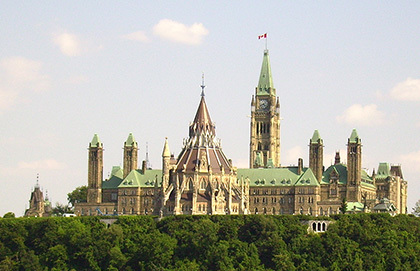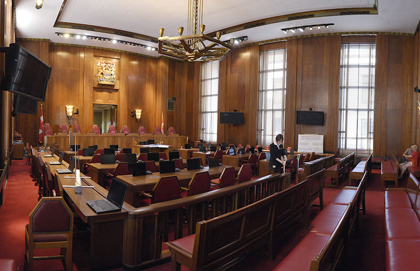Oddly enough, it began with a pill used to treat stomach ulcers. On December 9, 1986, the Federal Court of Appeal rendered its decision in Smith, Kline & French Laboratories Ltd. v. Canada (Attorney General), a case dealing with patents and intellectual property. In Smith, the plaintiff, who manufactured a pill for stomach ulcers, argued that the compulsory licence required for the production of medicine under section 41(4) of the Patent Act violated its right to equal treatment under the law as guaranteed by section 15 of the Charter of Rights and Freedoms. Although the plaintiff was unsuccessful, Justice Hugessen, writing for the Court, found that while it did not apply to the plaintiff in that particular case, section 15 of the Charter needed to be interpreted in a broad manner. He stated:
"As far as the text of section 15 itself is concerned, one may look to whether or not there is 'discrimination,' in the pejorative sense of that word, and as to whether the categories are based upon the grounds enumerated or grounds analogous to them. The inquiry, in effect, concentrates upon the personal characteristics of those who claim to have been unequally treated. Questions of stereotyping, of historical disadvantagement, in a word, of prejudice, are the focus and there may even be a recognition that for some people equality has a different meaning than for others."
Three years later, writing for the majority in the Supreme Court of Canada decision in Andrews v. Law Society of British Columbia, Justice Wilson adopted the approach set out by Hugessen in Smith. Wilson concluded that section 15 of the Charter forbids discrimination on the grounds enumerated in the section — race, national or ethnic origin, colour, religion, age or sex — as well as other grounds the court might consider as analogous to them. That February 2, 1989, decision in Andrews radically changed the way in which Canadian courts have interpreted section 15 of the Charter. Justice Wilson extended the protection of section 15 to non-citizens, setting in motion a series of top Court decisions that would lead to a redefinition of "human rights" (or "civil rights" as they're called under the Constitution Act) and, in time, to court-endorsed constriction of religious freedom in Canada.
The philosophical roots of the concept of freedom of religion can be traced back to the time of Aristotle, but it was the stoic philosophers, who believed that all human beings are fundamentally equal, who developed the concept of "natural law" as we know it today. In the Middle Ages, Christian scholastics such as Thomas Aquinas, who believed in the Christian doctrine of the Imago Dei, merged the concepts of Aristotelian logic and natural law with Catholic theology to develop philosophies of conscience and justice that posited that natural law was a principle that no man could violate — in other words, that all have inalienable human rights.
In April 1982, Canada stepped beyond its long tradition of court decisions and its briefer experience with human rights legislation to constitutionally entrench the right to freedom of religion in the Canadian Charter of Rights and Freedoms. In 1960, the Canadian Bill of Rights had expressly recognized the supremacy of God and the dignity and worth of the human person, and called for the protection of freedom of religion; but the Bill of Rights was constitutionally confined to federal jurisdiction only. Through federal-provincial agreement, the Charter expanded the jurisdiction of the concepts found in the Bill of Rights and other legislative and judicial pronouncements on freedom of religion to a constitutionally enshrined relationship between all Canadian governments — federal, provincial, municipal, school boards — and the people of the nation.
While Canadians, like many others, had been responsible for discrimination and religious persecution (to varying degrees), our legal and political systems, even sans the Charter, were able to address these injustices. For example, in the 1950s, a series of Supreme Court of Canada decisions ended the decades-long persecution and discrimination against Jehovah's Witnesses. A series of decisions culminated in the 1959 case of Roncarelli v. Duplessis, in which the Supreme Court ordered the Premier of Quebec to pay damages for having used his power and influence to discriminate against a Jehovah's Witness businessman simply on the basis of their personal religious differences.
The Charter was intended to capture that history, using it to establish a foundation for the future. But how far, if at all, have we progressed with regard to freedom of religion in Canada? Is freedom of religion more protected now than it was in 1982? Has the Charter made things better? Or have we regressed in regard to freedom of religion? Has freedom of religion been curtailed under the Charter? Or are we constantly playing a game of constitutional tug-of-war with religious freedom? Let's briefly consider these questions with the goal of assessing the current state of freedom of religion in Canada.
The first and still the leading case on the Charter's section 2(a) right to freedom of religion was R. v. Big M Drug Mart. The case dealt with a drugstore that had been fined for opening on Sundays, contrary to the federal Lord's Day Act. Ultimately, the law was struck down as violating section 2(a) of the Charter because its purpose was found to be the establishment of a religious observance. In this decision, the Supreme Court defined freedom of religion as including "the right to entertain such religious beliefs as a person chooses, the right to declare religious beliefs openly and without fear of hindrance or reprisal, and the right to manifest religious belief by worship and practice or by teaching and dissemination."
Over the ensuing two decades, Canada's Supreme Court rendered several decisions upholding and expanding religious freedom. These included declarations that employers were required to accommodate employees not wanting to work on religious holidays or holy days because of personal religious beliefs; that accrediting bodies could not reject applications for accreditation solely because the applicant was religious; that so long as religious beliefs were sincerely held, they were protected; that clergy who objected to same-sex marriage for religious reasons could not be forced to officiate such marriages; and that religious emblems should be allowed to be worn in schools by students.
In the overwhelming majority of cases in which a positive claim to religious freedom was made during the first 25 years of the Charter, the Supreme Court upheld freedom of religion and defined it in a broad manner. Indeed, in its 2004 decision in Syndicat Northcrest v. Amselem, the Court concluded that "the State is in no position to be, nor should it become, the arbiter of religious dogma." And in Reference Re Same-Sex Marriage, that same year, the Court stated that "the protection of freedom of religion afforded by section 2(a) of the Charter is broad and jealously guarded" in Charter jurisprudence.
However, in 2007, the 26th year after the Charter came into force, something changed. We no longer see as vigorous a protection of freedom of religion in the decisions of the Court. In fact, over the past eight years, the Supreme Court decisions that have curtailed freedom of religion significantly outnumber those that have upheld it.
From 2007 to 2015, there were only six cases in which a positive claim for religious freedom was advanced. Of those six, one resulted in the Court sending the issue back to a lower level of decision making with instructions on how to proceed (R. v. N.S.), one resulted in the religious freedom claim being protected (Loyola High School v. Quebec) and four resulted in the claimed freedom of religion being rejected or restricted in favour of a competing interest (Alberta v. Hutterian Brethren, S.L. v. Commission scolaire des Chênes, Whatcott v. Saskatchewan and A.C. v. Manitoba). While the number of relevant cases is fewer than in the first 25 years of the Charter, now the overwhelming majority result in religious freedom being limited.
The recent judicial attitude toward religious freedom, and more specifically the willingness of the courts to set limits on religious freedom, may be due to a perceived change in Canadian culture. This pattern is seen in examination of recent Supreme Court jurisprudence but is even more apparent when looking at non-Supreme Court of Canada court cases. The most serious limitation of religious freedom is taking place at lower court levels and through decisions of human rights tribunals.
At the outset, I suggested that it started with a pill for stomach ulcers. The Smith patent case led to the expansion of section 15 of the Charter, equality before and under the law provision, to "analogous grounds." Following the rationale in the Andrews case, which first expanded section 15 rights, analogous grounds have been found to include marital status (including protection for common-law partnerships), sexual orientation, off-reserve aboriginal status and citizenship (or non-citizenship). Although not all of the six freedom of religion cases before the Supreme Court in the past eight years have dealt with competing rights between religious freedom and other Charter rights, the expanded interpretation of section 15 by the courts, particularly the Supreme Court of Canada, has contributed to a dramatic change in societal and judicial attitudes toward religious individuals, communities and institutions and the constitutional guarantee of their religious freedom.
In recent years, perhaps as a result of this shift with respect to freedom of religion, Canadian courts, including the Supreme Court, have adopted an approach that some refer to as "judicial activism" but that others refer to as a "living tree" approach to interpreting the Constitution. Recent and perhaps more high-profile examples of this have been the Bedford prostitution decision and the Carter assisted-suicide decision in which the Court reversed its earlier decisions. Likewise, the reference regarding the appointment of Justice Nadon to the Supreme Court, in which the Court came up with its own definition of certain terms in the Supreme Court Act, is also emblematic of this approach. In each of these decisions, according to several lawyers and scholars, the Supreme Court made decisions seemingly in spite of the law not by virtue of it. Indeed, in the Bedford case, Chief Justice McLachlin stated that lower-court judges are not necessarily bound by higher-court precedents, which is the foundation of Canada's jurisprudential system. In essence, what may have been constitutional 15 years ago is not necessarily constitutional today. In simpler terms, out with the old and in with the new.
Looking at the cases and issues surrounding freedom of religion since 2007, a different pattern emerges. Courts, governments and administrative bodies now appear prepared to curtail freedom of religion in favour of other competing rights. In some cases, they have done so even when no competing rights exist or where there are competing interests but it is not necessary to choose one over the other.
Since the celebration of the Charter's silver anniversary, a number of lower court and tribunal decisions have resulted in the limiting of religious freedom under the pretext of balancing alleged competing rights or the alleged preservation of equal treatment under the law for certain identifiable groups. Some examples include human rights tribunals concluding that a religious charity has no claim to religious freedom in its hiring practices because it is not serving exclusively religious individuals, that an editorial commentary on homosexuality written by a Christian pastor constitutes hate speech, and that marriage commissioners (marriage officiants acting in a non-clergy capacity) must officiate same-sex weddings even if doing so violates their religious beliefs.
Outside the courts, there has been additional movement toward limiting freedom of religion.
In Ontario, Manitoba and Alberta, the provincial governments enacted legislation requiring all schools, including faith-based schools, to create and maintain Gay-Straight Alliance clubs that promote conduct and behaviour several faith-based schools find to be sinful or immoral for religious reasons. The rationale for the legislation was to protect children from being bullied, but it ignored the fact that the most frequent instances of bullying are not based on sexual orientation. The incidence of school bullying is demonstrably higher based on religious beliefs, and, as might be expected, is greatest based on body image.
In Ontario, Nova Scotia and British Columbia, law societies voted to refuse graduates from Trinity Western University's proposed law school because the university asks its students to live a lifestyle consistent with Christian principles. This was ostensibly done to protect LGBT law students from being discriminated against but ignores the fact that Trinity Western does not deny LGBT students from applying or attending. In fact, the Supreme Court of Canada ruled in favour of Trinity in a similar case in 2001.
In Ontario, the College of Physicians and Surgeons of Ontario introduced a policy that requires physicians to engage in procedures to which they object on religious or conscience grounds. The College of Physicians and Surgeons of Saskatchewan is considering a similar policy. In both instances, the objective is allegedly to ensure the full range of medical services is available to patients. However, physicians with specialties are not required to practice outside their area of specialization, and so those with religious or conscientious objections are forced to specialize, leave the practice of medicine or move to a province or country that will accept them. One would think that providing medical services to patients begins with providing physicians to serve them.
What appears to be the prevailing idea is that in order to advance the position of one group, such as the LGBT community or women who want unhindered access to abortion and birth control, it's necessary to remove or restrict religious freedom. Or perhaps it's the notion that religious claims primarily seek to deny inclusion, which is advanced by some in academia, such as the activist Donn Short at the University of Manitoba. Either way, since 2007, a trend of trampling on religious freedom has emerged in Canada. This is due to the Supreme Court of Canada's expansion of Charter rights beyond what was voted on in Parliament and legislatures across the nation when establishing the Charter in the first place. To borrow a line from a colleague, instead of treating the Charter like a living tree, which is organic and adapts to changing times, some treat it like a living mutant organism that can be pruned, have new branches grafted on or just grow new branches all on its own.
The first months of 2015 have been more encouraging. We are witnessing what is hopefully a new trend in legal decisions reaffirming earlier Charter concepts of religious freedom. In January, in a labour case involving freedom of association, the Supreme Court provided some strong language in favour of religious communities' right to exist autonomously. In January, the Nova Scotia Supreme Court ruled in favour of Trinity Western University in its challenge to the decision of the Nova Scotia Barristers' Society denying admission to Trinity Western graduates to the practice of law in that province. In March, the Supreme Court of Canada ruled in favour of Loyola High School, affirming that it was unreasonable for the Government of Quebec to force a Catholic school to teach Catholicism in a "neutral," non-Catholic way. And in April, in a case on State neutrality with respect to religion, the Court determined that a specific prayer before city council meetings offended the State's duty to remain neutral but affirmed that there is a place in the public square for religious expression.
That is four strong decisions in favour of religious freedom. Will the positive trend continue into summer, autumn and beyond? Could it be that after eight years the tide has turned? Will Canada once again be identified as a society in which freedom of religion is broad and jealously guarded? Only time will tell.






